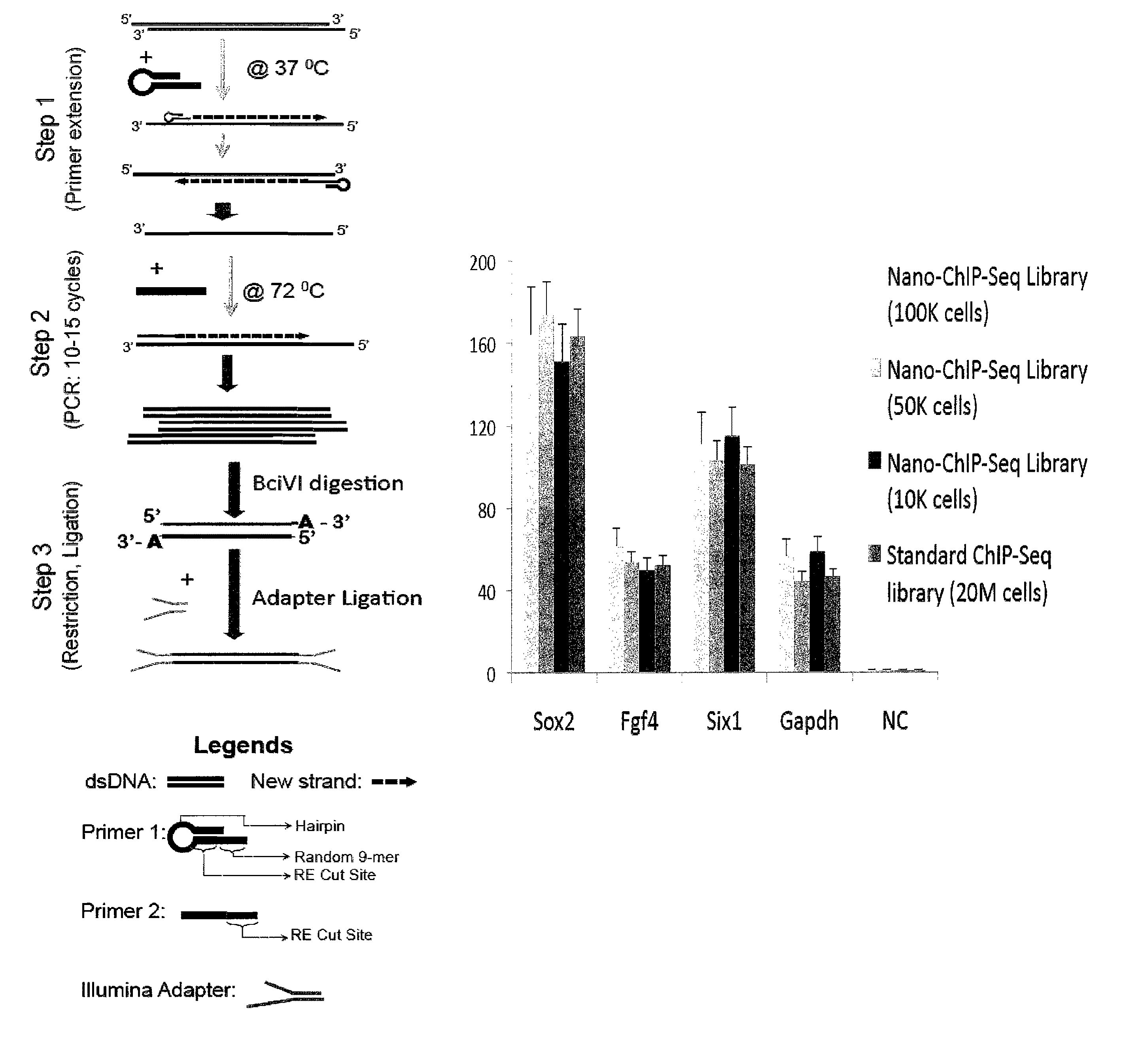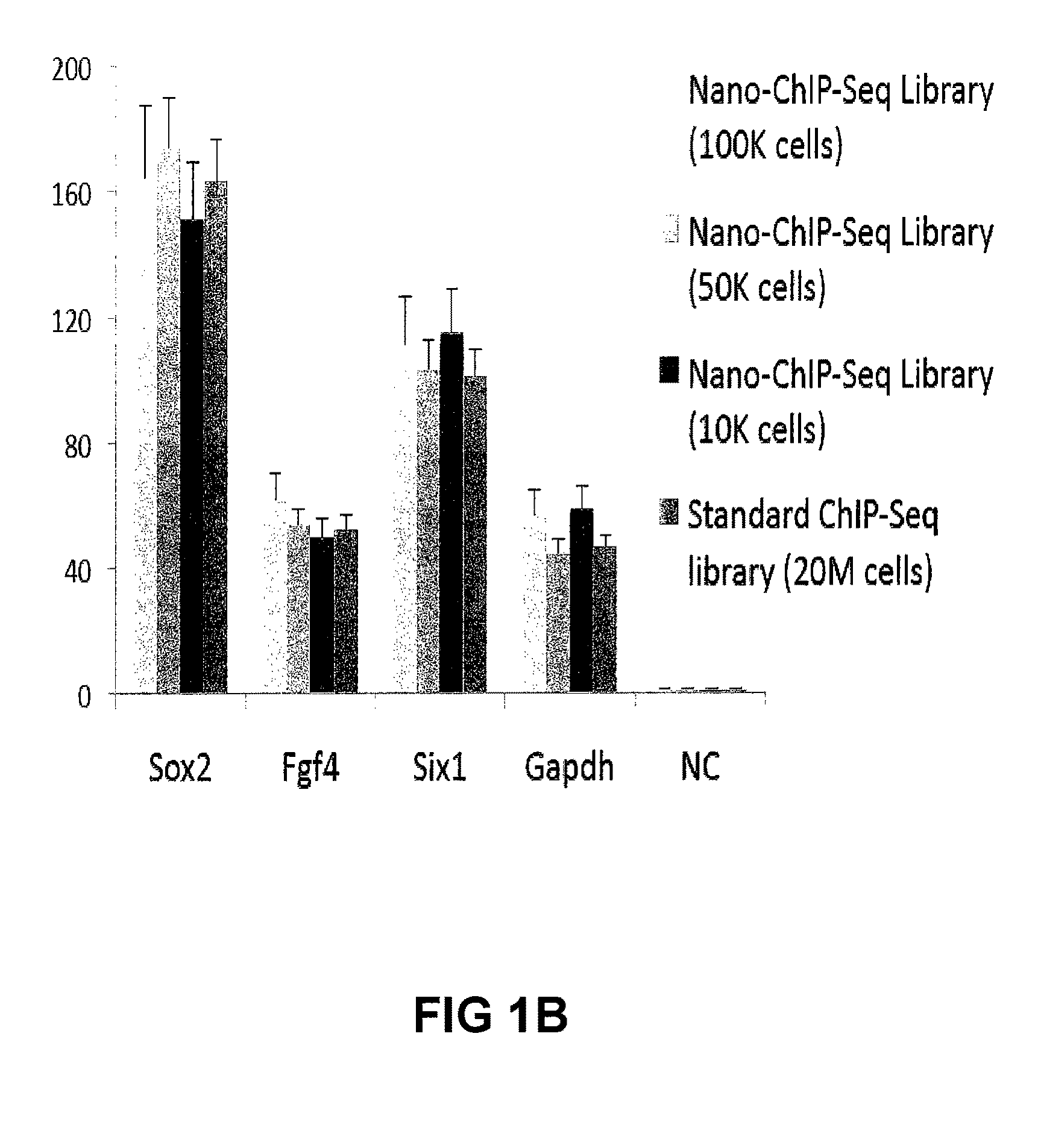Methods for preparing sequencing libraries
a sequencing library and sequencing technology, applied in the field of gene expression mapping and high throughput sequencing, can solve the problems of limiting the applicability of the technology to experiments, and many cell populations and tissues are not amenable to chromatin state analysis
- Summary
- Abstract
- Description
- Claims
- Application Information
AI Technical Summary
Benefits of technology
Problems solved by technology
Method used
Image
Examples
example 1
Cell Acquisition
[0216]Mouse V6.5 embryonic stem (ES) cells were grown for two passages on 0.2% gelatin-coated plates containing DMEM media supplemented with 15% FCS, LIF, penicillin-streptomycin, Glutamax (Invitrogen), nonessential amino acids and 2-mercaptoethanol in 5% CO2 at 37° C. “Lineage-, Sca-1+, c-kit+” (LSK) cells were enriched from murine bone marrow using a fluorescence-activated cell sorting (FACS) method on a Vantage Cell Sorter (Becton Dickinson, Mountain View, Calif.). Varnum-Finney et al., “Notch target Hes5 ensures appropriate Notch induced T-versus B-cell choices in the thymus”Blood 111:2615-2620 (2008).
example ii
[0217]Approximately 10,000 embryonic stem (ES) cells, counted with a haemocytometer, or approximately 20,000 FACS-sorted LSK cells were used for each ChIP assay.
[0218]Cells were cross linked with 1% formaldehyde in 1 ml phosphate buffered saline (PBS) at room temperature for 10 minutes. After quenching with glycine for 5 min, the cells were washed twice with ice cold PBS with 10% serum. The addition of serum enhanced cell recovery during the washing steps. Cells were collected after each wash by centrifugation at 5000 rpm for 3 min. Cell pellets were re-suspended in 100 μl of lysis buffer containing 1% SDS, 10 mM EDTA, 50 mM Tris-HCl (pH 8.1) and flash frozen and stored at −80° C.
[0219]At the time of the experiment, cells were thawed and kept on ice for 10 min to allow lysis. Lysate was then diluted with 400 μl of ChIP dilution buffer containing 0.01% SDS, 1.1% Triton X-100, 1.2 mM EDTA, 16.7 mM Tris-HCl (pH ˜8.1). Lysis buffer was diluted before sonicatio...
example iii
Nano-ChIP-Seq Library Preparation
The library method described here is composed of three major steps:
[0222]Step 1: ChIP DNA from 10,000-2,000 cells (estimated at 10-50 picograms), prepared in accordance with Example II, is primed with a modified universal primer (i.e., for example, 5′-GACATGTATCCGGATGT↓NNNNNNNNN-3′ (SEQ ID NO:1)) for four priming cycles to create template DNA with common primer sequence incorporated at both the 5′ and 3′ ends. The modified universal primer contains a common PCR sequence (italicized), a restriction site for BciVI (underlined sequence; arrow indicates location of BciVI restriction enzyme cleavage) and a random 9-mer at the 3′ end (N . . . N). The priming is achieved using Sequenase V2.0 (US Biochemical 70775), and a DNA polymerase with strand displacement capability but no 3′→5′ exonuclease activity. 7 μl of ChIP DNA was incubated with 1 μl of the modified universal primer (2 mM stock) and 2 ml of Sequenase buffer at 98° C. briefly, and then annealed a...
PUM
| Property | Measurement | Unit |
|---|---|---|
| Tm | aaaaa | aaaaa |
| pH | aaaaa | aaaaa |
| temperature | aaaaa | aaaaa |
Abstract
Description
Claims
Application Information
 Login to View More
Login to View More - R&D
- Intellectual Property
- Life Sciences
- Materials
- Tech Scout
- Unparalleled Data Quality
- Higher Quality Content
- 60% Fewer Hallucinations
Browse by: Latest US Patents, China's latest patents, Technical Efficacy Thesaurus, Application Domain, Technology Topic, Popular Technical Reports.
© 2025 PatSnap. All rights reserved.Legal|Privacy policy|Modern Slavery Act Transparency Statement|Sitemap|About US| Contact US: help@patsnap.com



